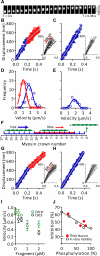Molecular mechanics of cardiac myosin-binding protein C in native thick filaments
- PMID: 22923435
- PMCID: PMC3561468
- DOI: 10.1126/science.1223602
Molecular mechanics of cardiac myosin-binding protein C in native thick filaments
Abstract
The heart's pumping capacity results from highly regulated interactions of actomyosin molecular motors. Mutations in the gene for a potential regulator of these motors, cardiac myosin-binding protein C (cMyBP-C), cause hypertrophic cardiomyopathy. However, cMyBP-C's ability to modulate cardiac contractility is not well understood. Using single-particle fluorescence imaging techniques, transgenic protein expression, proteomics, and modeling, we found that cMyBP-C slowed actomyosin motion generation in native cardiac thick filaments. This mechanical effect was localized to where cMyBP-C resides within the thick filament (i.e., the C-zones) and was modulated by phosphorylation and site-specific proteolytic degradation. These results provide molecular insight into why cMyBP-C should be considered a member of a tripartite complex with actin and myosin that allows fine tuning of cardiac muscle contraction.
Figures


Comment in
-
Cell biology. Heart brakes.Science. 2012 Sep 7;337(6099):1182-3. doi: 10.1126/science.1227943. Science. 2012. PMID: 22955824 No abstract available.
References
-
- Winegrad S. Cardiac myosin binding protein C. Circ Res. 1999;84:1117. - PubMed
Publication types
MeSH terms
Substances
Grants and funding
LinkOut - more resources
Full Text Sources
Other Literature Sources
Medical
Molecular Biology Databases

